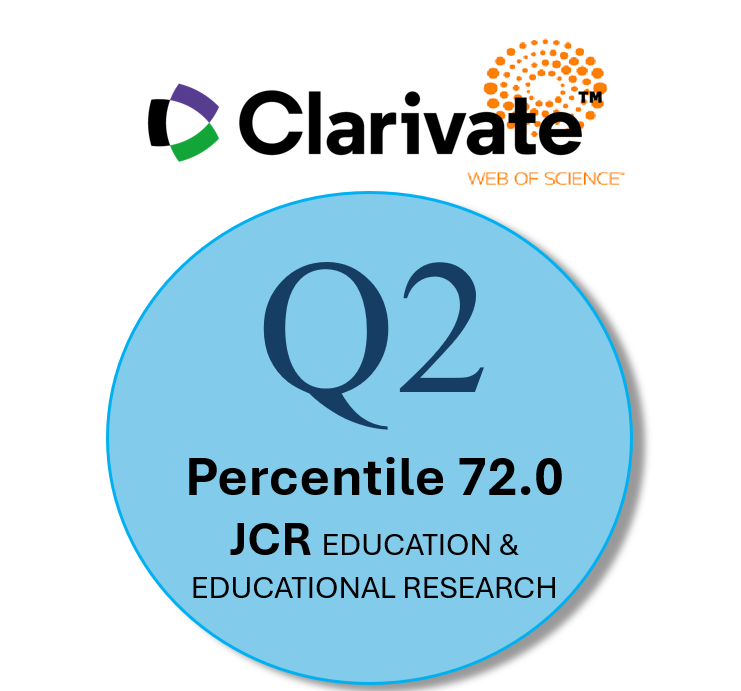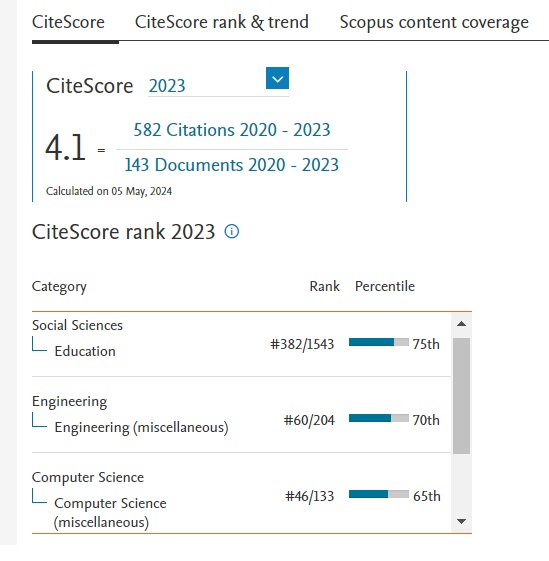Evaluación del pensamiento computacional para el aprendizaje de programación de computadoras en educación superior
Resumen
El trabajo describe los resultados que se han obtenido de la evaluación del pensamiento computacional del 2016 al 2019 para determinar un estado diagnóstico de los estudiantes que cursan la materia inicial programación de computadoras en educación superior. El caso de estudio se enmarca en el nivel técnico superior universitario en Puebla-México, pero se ha realizado también un diseño experimental para la universidad tecnológica de Chile. Por medio de la selección de cinco reactivos en correspondencia a cinco habilidades del pensamiento computacional (abstracción, generalización, descomposición, diseño algorítmico y evaluación) se establece una relación con los contenidos temáticos del curso, por lo anterior, se ha podido determinar cuales serían las fortalezas y debilidades de los estudiantes con el objetivo de apoyar su desempeño académico. Dos resultados destacan del trabajo realizado. Primero, conocer a través de dos encuestas solicitadas durante cada intervención, el impacto en los estudiantes de la evaluación para la adquisición de las competencias. Segundo, a partir de la tercera intervención, obtener una predicción de la retención de matrícula al menos para el primer cuatrimestre.
Descargas
-
Resumen4410
-
PDF14910
Citas
Barr, V., & Stephenson, C. (2011). Bringing computational thinking to K-12: what is Involved and what is the role of the computer science education community? ACM Inroads, 2(1), 48-54. doi:10.1145/1929887.1929905
Bureau_of_Labor_Statistics. (2019). U.S. Department of Labor. Obtenido de Occupational Outlook Handbook, Software Developers: https://www.bls.gov/ooh/computer-and-information-technology/software-developers.htm#tab-6
Chen, G.-m. (2017). Programming Language Teaching Model Based on Computational Thinking and Problem-based Learning. Proceedings of the 2017 2nd International Seminar on Education Innovation and Economic Management (SEIEM 2017). Atlantis Press. doi:10.2991/seiem-17.2018.31
Chiazzese, G., Fulantelli, G., Pipitone, V., & Taibi, D. (2017). Promoting computational thinking and creativeness in primary school children. TEEM 2017 Proceedings of the 5th International Conference on Technological Ecosystems for Enhancing Multiculturality (pág. Article No. 6). Cádiz, Spain — October 18 - 20: ACM New York, NY, USA. doi:10.1145/3144826.3145354
Chiazzese, G., Fulantelli, G., Pipitone, V., & Taibi, D. (2018). Involucrando a los niños de educación primaria en el Pensamiento Computacional: diseñando y desarrollando videojuegos. Education in the Knowledge Society, 19(2), 63-81. doi:10.14201/eks20181926381
Chilana, P. K., Alcock, C., Dembla, S., Ho, A., Hurst, A., Armstrong, B., & Guo, P. J. (2015). Perceptions of non-CS majors in intro programming: The rise of the conversational programmer. 2015 IEEE Symposium on Visual Languages and Human-Centric Computing (VL/HCC) (págs. 251-259). Atlanta, GA, USA: IEEE. doi:10.1109/VLHCC.2015.7357224
Compañ-Rosique, P., Satorre-Cuerda, R., Llorens-Largo, F., & Molina-Carmona, R. (2015). Enseñando a programar: un camino directo para desarrollar el pensamiento computacional. Revista de Educación a Distancia, 46(11). doi:10.6018/red/46/11
Czerkawski, B. C., & Lyman, E. W. (2015). Exploring Issues About Computational Thinking in Higher Education. TechTrends, 59(2), 57–65. doi:10.1007/s11528-015-0840-3
Echegaray, G., Barroso, N., Laskurain, I., Zuza, K., & Barragués, J. I. (2017). Investigación cualitativa para la mejora de los resultados académicos en primer curso en los grados de Ingeniería de la Escuela de Ingeniería de Gipuzkoa. IV Congreso Internacional sobre Aprendizaje, Innovación y Competitividad-CINAIC (Zaragoza 4-6 Octubre 2017). doi:10.26754/CINAIC.2017.000001_093
Espino, E. E., & González, C. S. (2015). Influence of Gender on Computational Thinking. Interacción '15 Proceedings of the XVI International Conference on Human Computer Interaction (pág. art. no. 36). Vilanova i la Geltru, Spain — September 07 - 09: ACM New York, NY, USA. doi:10.1145/2829875.2829904
Gao, Q. (2014). The computational thinking- oriented inquiry teaching mode for advanced programming language course. Bio Technology: A Indian Journal, 10(12), 6588-6595. Obtenido de https://www.tsijournals.com/articles/the-computational-thinking-oriented-inquiry-teaching-mode-for-advanced-programming-language-course.pdf
García-Peñalvo, F. J. (2016). What Computational Thinking Is. Journal of Information Technology Research, 9(3), v-viii.
García-Peñalvo, F. J. (2018). Computational thinking. IEEE Revista Iberoamericana de Tecnologías del Aprendizaje (IEEE RITA), 13(1), 17-19. doi:10.1109/RITA.2018.280993
García-Peñalvo, F. J., & Cruz-Benito, J. (2016). Computational thinking in pre-university education. En F. J. García-Peñalvo (Ed.), TEEM '16 Proceedings of the Fourth International Conference on Technological Ecosystems for Enhancing Multiculturality (págs. 13-17). Salamanca, Spain: ACM, New York, NY, USA. doi:10.1145/3012430.3012490
García-Peñalvo, F. J., & Mendes, A. J. (2018). Exploring the computational thinking effects in pre-university education. Computers in Human Behavior, 80, 407-411. doi:10.1016/j.chb.2017.12.005
García-Peñalvo, F. J., Reimann, D., & Maday, C. (2018). Introducing Coding and Computational Thinking in the Schools: The TACCLE 3 – Coding Project Experience. En M. Khine (Ed.). Computational Thinking in the STEM Disciplines, Springer, Cham. doi:10.1007/978-3-319-93566-9_11
García-Peñalvo, F. J., Reimann, D., Tuul, M., Rees, A., & Jormanainen, I. (2016). An overview of the most relevant literature on coding and computational thinking with emphasis on the relevant issues for teachers. Belgium: TACCLE 3 Consortium. doi:10.5281/zenodo.16512
García-Vega, M. Á. (2019). Automatización: así es la batalla entre trabajo y tecnología. Revista Retina. Obtenido de https://retina.elpais.com/retina/2019/05/24/tendencias/1558680372_855666.html?id_externo_rsoc=TW_CM
Google for Education. (2016). Exploring Computational Thinking. Obtenido de https://www.google.com/edu/resources/programs/exploring-computational-thinking/
Hamlin, B., Riehl, J., Hamlin, A. J., & Monte, A. (2010). Work in progress — What are you thinking? Over confidence in first year students. 2010 IEEE Frontiers in Education Conference (FIE) (págs. F2H1-F2H2). Washington, DC, USA: IEEE. doi:10.1109/FIE.2010.5673354
Huang, W., Deng, Z., & Rongsheng, D. (2009). Programming Courses Teaching Method for Ability Enhancement of Computational Thinking. 2009 International Association of Computer Science and Information Technology - Spring Conference (págs. 182-185). Singapore, Singapore: IEEE. doi:10.1109/IACSIT-SC.2009.52
Kazimoglu, C., Kiernan, M., Bacon, L., & MacKinnon, L. (2012). Learning Programming at the Computational Thinking Level via Digital Game-Play. Procedia Computer Science, 9, 522-531. doi:10.1016/j.procs.2012.04.056
Larkins, D. B., & Harvey, W. (2010). Introductory computational science using MATLAB and image processing. Procedia Computer Science, 1(1), 913-919. doi:10.1016/j.procs.2010.04.100
Lingling, Z., Xiaohong, S., & Tiantian, W. (2015). Bring CS2013 Recommendations into c Programming Course. Procedia - Social and Behavioral Sciences, 176, 194-199. doi:10.1016/j.sbspro.2015.01.461
Lye, S. Y., & Koh, J. H. (2014). Review on teaching and learning of computational thinking through programming: What is next for K-12? Computers in Human Behavior, 41, 51-61. doi:10.1016/j.chb.2014.09.012
Mazaika, K. (2017). Will The Demand For Developers Continue To Increase? Forbes. Obtenido de https://www.forbes.com/sites/quora/2017/01/20/will-the-demand-for-developers-continue-to-increase/#1272429e33ee
Michaelson, G. (2015). Teaching Programming with Computational and Informational Thinking. Journal of Pedagogic Development, 5(1). Obtenido de https://www.beds.ac.uk/jpd/volume-5-issue-1-march-2015/teaching-programming-with-computational-and-informational-thinking
Milne, I., & Rowe, G. (2002). Difficulties in Learning and Teaching Programming—Views of Students and Tutors. Education and Information Technologies, 7(1), 55-66. doi:10.1023/A:1015362608943
Ni, Z. (2017). Discussion on Case Teaching Method Based on Computational Thinking in Programming Teaching. 2017 International Conference on Social science, Education and Humanities Research (ICSEHR 2017). Atlantis Press. doi:10.2991/icsehr-17.2017.9
Olivares, J. C., Jiménez, J. A., Ortiz, O., & Rodríguez, N. (2015). Desarrollo de una aplicación para fortalecer el aprendizaje de los fundamentos de programación. Revista de ciencia e ingeniería del instituto tecnológico superior de Coatzacoalcos, 2(2).
Pólya, G. (1957). How to solve it. United States of America: Anchor books edition.
Ramirez-Lopez, A., & Muñoz, D. F. (2015). Increasing Practical Lessons and Inclusion of Applied Examples to Motivate University Students during Programming Courses. Procedia - Social and Behavioral Sciences, 176, 552-564. doi:10.1016/j.sbspro.2015.01.510
Rojas-López, A., & García-Peñalvo, F. J. (2018). Learning Scenarios for the Subject Methodology of Programming from Evaluating the Computational Thinking of New Students. IEEE Revista Iberoamericana de Tecnologías del Aprendizaje, 13(1), 30-36. doi:10.1109/RITA.2018.2809941
Román, M., Pérez, J. C., & Jiménez, C. (2015). Test de Pensamiento Computacional: diseño y psicometría general Computational Thinking Test: design & general psychometry. III Congreso Internacional sobre Aprendizaje, Innovación y Competitividad (CINAIC 2015), Octubre 14-16. Madrid, ESPAÑA.
Romero, M., Lepage, A., & Lille, B. (2017). Computational thinking development through creative programming in higher education. International Journal of Educational Technology in Higher Education, 14-42. doi:10.1186/s41239-017-0080-z
Royal Society. (2012). Shut down or restart: The way forward for computing in UK schools. Obtenido de https://royalsociety.org/~/media/education/computing-in-schools/2012-01-12-computing-in-schools.pdf
Sakhnini, V., & Hazzan, O. (2008). Reducing Abstraction in High School Computer Science Education: The Case of Definition, Implementation, and Use of Abstract Data Types. Journal on Educational Resources in Computing (JERIC), 8(2), 1-13. doi:10.1145/1362787.1362789
Selby, C. C. (2015). Relationships: computational thinking, pedagogy of programming, and Bloom's Taxonomy. WiPSCE '15 Proceedings of the Workshop in Primary and Secondary Computing Education (págs. 80-87). London, United Kingdom: ACM New York, NY, USA. doi:10.1145/2818314.2818315
Shiflet, G. W., & Shifleta, A. B. (2012). Introducing Life Science Doctoral Students in Oz to the Wizardry of Computational Modeling: Introducing Computational Thinking with CellDesigner™. Procedia Computer Science, 9, 1753-1762. doi:10.1016/j.procs.2012.04.193
Swaid, S. I. (2015). Bringing Computational Thinking to STEM Education. Procedia Manufacturing, 3, 3657-3662. doi:10.1016/j.promfg.2015.07.761
Talent Search. (2015). Elite: Grade 12+, Institute of IT Professionals South Africa. Obtenido de http://www.olympiad.org.za
UK Bebras Computational Thinking Challenge. (2015). answers (2015), University of Oxford. Obtenido de http://www.bebras.org
Walker, H. M. (2015). Computational thinking in a non-majors CS course requires a programming component. ACM Inroads, 6(1), 58-61. doi:10.1145/2727126
Weese, J. L. (2016). Mixed Methods for the Assessment and Incorporation of Computational Thinking in K-12 and Higher Education. ICER '16 Proceedings of the 2016 ACM Conference on International Computing Education Research (págs. 279-280). Melbourne, VIC, Australia — September 08 - 12: ACM New York, NY, USA. doi:10.1145/2960310.2960347
Wing, J. M. (2006). Computational thinking. Communications of the ACM, 49(3), 33-35. doi:10.1145/1118178.1118215
Wing, J. M. (2011). Research Notebook: Computational Thinking--What and Why? Obtenido de The Link, The magazine of the Carnegie Mellon University School of Computer Science: https://www.cs.cmu.edu/link/research-notebook-computational-thinking-what-and-why
Xia, A. (2016). On the Basis of the Program Design Teaching and Research of Cultivation of Computational Thinking Ability. Proceedings of the 2016 2nd International Conference on Social Science and Higher Education. Atlantis Press. doi:10.2991/icsshe-16.2016.83
Ying, L., & Pingping, L. (2017). Research on the teaching of programming language based on Computational Thinking. Proceedings of the 2017 International Conference on Social science, Education and Humanities Research (ICSEHR 2017). Atlantis Press. doi:10.2991/icsehr-17.2017.17
Yinnan, Z., & Chaosheng, L. (2012). Training for computational thinking capability on programming language teaching. 2012 7th International Conference on Computer Science & Education (ICCSE) (págs. 1804-1809). Melbourne, VIC, Australia : IEEE. doi:10.1109/ICCSE.2012.6295420
Zapata-Ros, M. (2015). Pensamiento computacional: Una nueva alfabetización digital. Revista De Educación a Distancia, 46. Obtenido de https://revistas.um.es/red/article/view/240321
Zhang, C., Chen, X., & Li, J. (2011). Research of VB programming teaching mode based on the core of computational thinking ability training. 2011 6th International Conference on Computer Science & Education (ICCSE) (págs. 1260-1263). Singapore, Singapore: IEEE. doi:10.1109/ICCSE.2011.6028861
Zhi-Mei, C., & Xiang, L. (2016). The PBL teaching method research based on computational thinking in C programming. 2nd International Conference on Modern Education and Social Science, (págs. 405-409). doi:10.12783/dtssehs/mess2016/9624
Las obras que se publican en esta revista están sujetas a los siguientes términos:
1. El Servicio de Publicaciones de la Universidad de Murcia (la editorial) conserva los derechos patrimoniales (copyright) de las obras publicadas, y favorece y permite la reutilización de las mismas bajo la licencia de uso indicada en el punto 2.
2. Las obras se publican en la edición electrónica de la revista bajo una licencia Creative Commons Reconocimiento-NoComercial-SinObraDerivada 3.0 España (texto legal). Se pueden copiar, usar, difundir, transmitir y exponer públicamente, siempre que: i) se cite la autoría y la fuente original de su publicación (revista, editorial y URL de la obra); ii) no se usen para fines comerciales; iii) se mencione la existencia y especificaciones de esta licencia de uso.
3. Condiciones de auto-archivo. Se permite y se anima a los autores a difundir electrónicamente las versiones pre-print (versión antes de ser evaluada) y/o post-print (versión evaluada y aceptada para su publicación) de sus obras antes de su publicación, ya que favorece su circulación y difusión más temprana y con ello un posible aumento en su citación y alcance entre la comunidad académica. Color RoMEO: verde.














